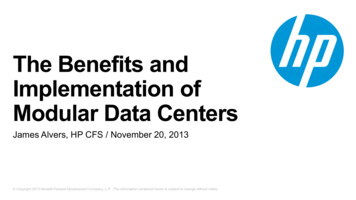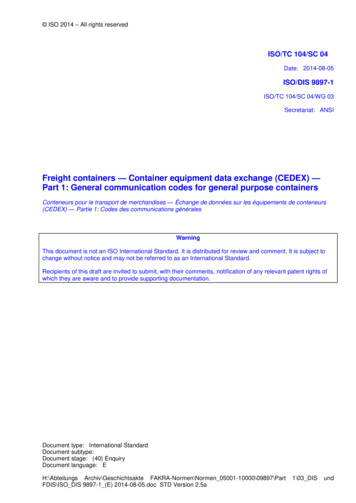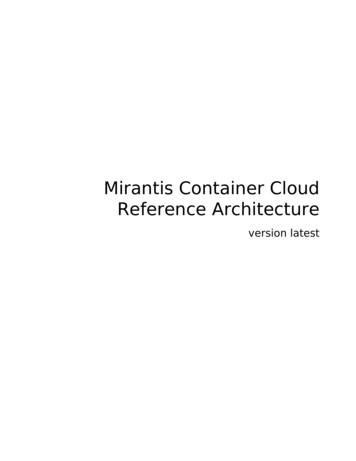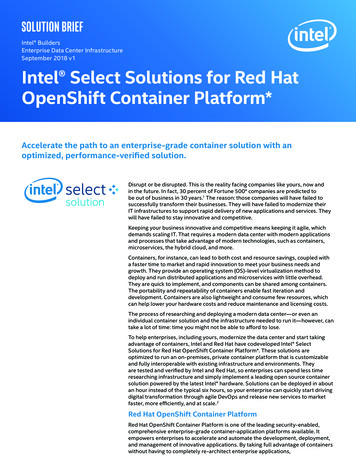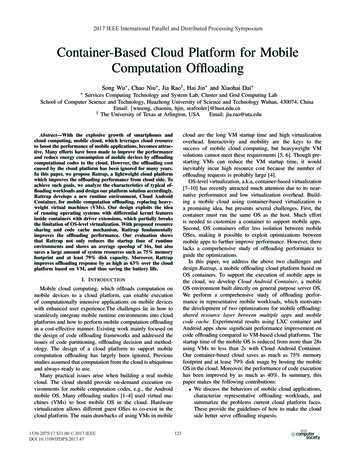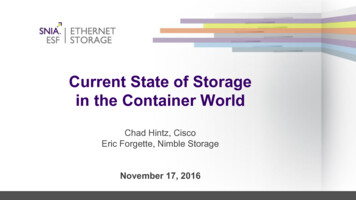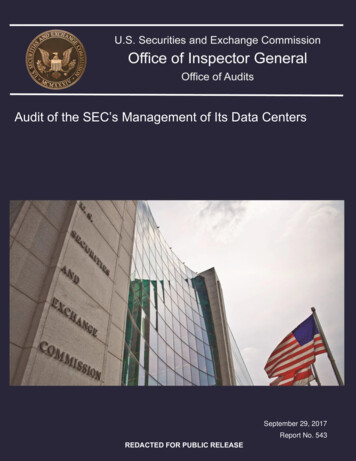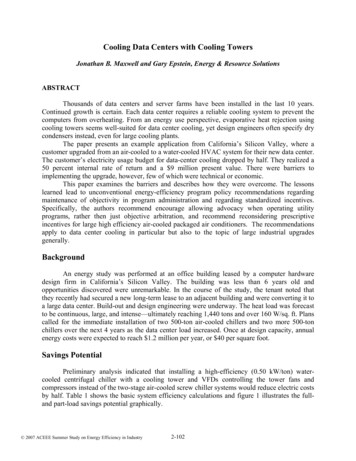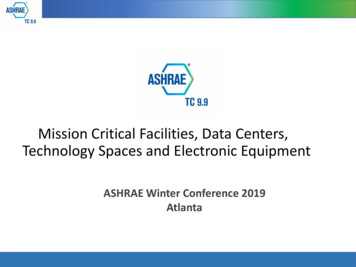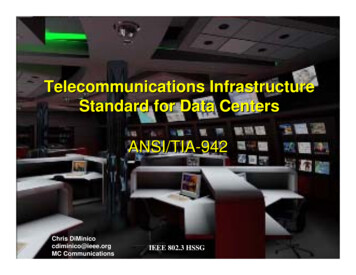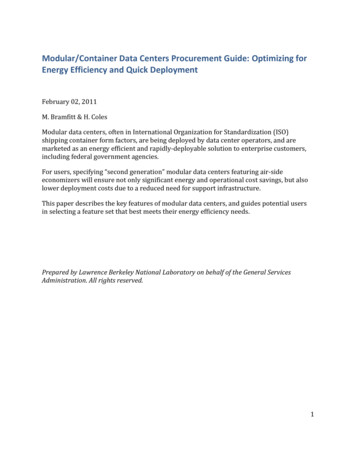
Transcription
Modular/Container Data Centers Procurement Guide: Optimizing forEnergy Efficiency and Quick DeploymentFebruary 02, 2011M. Bramfitt & H. ColesModular data centers, often in International Organization for Standardization (ISO)shipping container form factors, are being deployed by data center operators, and aremarketed as an energy efficient and rapidly-deployable solution to enterprise customers,including federal government agencies.For users, specifying “second generation” modular data centers featuring air-sideeconomizers will ensure not only significant energy and operational cost savings, but alsolower deployment costs due to a reduced need for support infrastructure.This paper describes the key features of modular data centers, and guides potential usersin selecting a feature set that best meets their energy efficiency needs.Prepared by Lawrence Berkeley National Laboratory on behalf of the General ServicesAdministration. All rights reserved.1
Table of Contents1Executive Summary. 43Product Description . 72Introduction . 53.1Why Consider Modular Solutions . 73.3Second Generation Unit Configurations . 83.243.44.1IT Equipment Requirements . 114.3Additional Requirements . 124.4Other Considerations . 135.1Overview – Attributes of Modular Systems . 155.3Energy Efficiency Comparison Metric “PUE*”. 165.45.55.67Select Cooling Technology . 11Comparing Energy Efficiency of Modular Data Centers. 155.26Primary Attribute Comparison . 9Purchasing Considerations. 114.25First Generation Unit Configurations . 85.7Evaluating and Rating Energy Efficiency . 15Selected Modular Cooling System Types . 17Evaluation Notations . 18Results of Comparative Analysis of Selected Units . 19Utility Energy Efficiency Program Applicability . 20Conclusions. 21Acknowledgements . 222
89Appendix A: Resources - Vendor Contacts and Product Information . 23Appendix B: Chilled Water Plant Model . 2810 Appendix C: Diagram for PUE* Calculations. 3011 Appendix D: Calculation Details . 3112 Appendix E: Vendor Supplied Thermal Performance Information . 3313 Appendix F: Calculated Results . 3514 Appendix G: Table – Summary of Results . 3715 Appendix H: Utility Energy Efficiency Program Applicability . 3816 Appendix I: Modular Deployment Scenarios. 4016.1Scenario 1: Transition Retrofit . 4016.3Scenario 3: Greenfield Deployment . 4016.216.416.516.6Scenario 2: Adding Capacity to “Brick and Mortar” Data Center . 40Scenario 4: Deployment at Co-location Providers . 41Scenario 5: Emergency and Temporary Deployments. 41Scenario 6: Utility-Scale Data Centers . 413
1Executive SummaryModular data centers reached prominence in 2007, are now offered by many suppliers, andare being deployed by “utility scale” data center operators such as Microsoft and Googleand in smaller installations throughout the industry.These units, which are often packaged in standard shipping container formats, areincreasingly being marketed to users as a quickly deployable and energy efficientalternative to traditional data center designs.Some designs from an early generation of modular units have limited energy efficiencyadvantages compared to traditional data centers, and their deployment can be complicatedby a variety of infrastructure support needs, including the need for chilled water. Theymay remain a good choice in many cases including use as a short-term solution whileexisting facilities are rehabilitated, or in regions where climate conditions are not wellsuited for air-side economizer use. It should be noted that some recent designs using earlygeneration cooling approaches provide excellent energy use performanceThe latest modular units, which we have denoted as “second generation”, feature on-boardair-side economizer capabilities, often supplemented with evaporative cooling, obviatingthe need for a chilled water supply. These units therefore provide superior energyperformance, and could be deployed more quickly and less expensively.Six companies supplied thermal performance information used for an energy efficiencyanalysis for this guide. Modular data center offerings are changing rapidly, and the analysisrepresents a snap shot in time of available selected cooling system designs. The analysis ofselected products reveals that modular/container data centers that require a chilled watersupply have an average Power Utilization Effectiveness* (PUE*) of 1.16, while secondgeneration units have a PUE* as low as 1.02. 1Users considering modular/container data center solutions should carefully considerenergy efficiency attributes both as a means of limiting ongoing operational costs and alsoto minimize infrastructure expenses and installation time frames. Users will have theability to drive the market to higher levels of efficiency or demand response by placingrequirements in their procurement specifications. This could be driven by available poweror cooling options or simply for operating cost containment. Eventually as computationalmetrics are defined (computations/watt), container specification, comparison andselection could be on a holistic basis.1 PUE* is defined as (total power supplied to the module power to produce externally acquired chilled fluid) /IT power and is a rating developed for this paper specifically derived for modular/container units, ignoringlighting, UPS, external power transformers and backup generation. See section 5 and Appendix D.4
2IntroductionContainer/modular data centerinfrastructure units came to broad marketawareness in January 2007 with Sun’sdebut of “Project Blackbox”, althoughGoogle revealed in 2009 that it had built acontainer data center in 2005 afterdeveloping the concept in 2003. (Googlewas awarded a patent in October 2008.)Modular data center units are nowavailable from many vendors including:(see Appendix A for contact information) Figure 1: Sun “Project Blackbox” UnitHewlett-Packard: Performance Optimized Datacenter (POD) familyi/o Data Centers: i/o ANYWHERESGI: ICE Cube, ICE Cube Air Modular Data CenterPacific Voice & Data: MCIE (Modular Critical Infrastructure Enclosure) Solutions andDisaster Recovery Mobile Data CentersElliptical Mobile Solutions: MMDC (Micro Modular Data Center)Liebert: MDC20-XDR-53IBM: PMDC (Portable Modular Data Center)PDI: i-ConCirrascale: FOREST Containerized Data Center (formally Verari FOREST)Dell: HumidorOracle: Sun Modular Data Center (previously Sun “Project Blackbox”)Lee Technologies: ITModulesTelenetix: T-CubeUniversal Networking Services: Datapod Containerized SystemNxGen Modular: NxGEN600BladeRoom Group Ltd: Blade Room systemBull: MobullAlthough most units conform to standard shipping container form factors (10-, 20- and 40foot units), others are delivering units that are purpose built. Elliptical Mobile Solutions5
offers units at the smallest end of the scale, featuring single rack size solutions; othervendors such as SGI and i/o Data Centers offer modular units that can be “ganged” togetheror combined into large-scale deployments.A large container data center located in Oregonhouses forty-five 40-foot modular containers,with each container housing just over athousand servers and requiring about 250 kWof power. The facility has a floor area of75,000 square feet, and claims a Power UsageEffectiveness (PUE 2) of 1.25.Figure 2: Data Center Featuring ContainerUnits - Oregonmany as 2,500 servers has a claimed PUE of1.22.A large container data center in Chicago IL,where facility load total exceeds 100 MW, usesforty-foot modular containers, each housing asModular units are marketed to data centeroperators as a means of quickly addingcapacity at lower costs compared todevelopment of traditional “brick and mortar”data centers. Vendors are also portraying unitsas inherently more energy efficient, resulting inoperating cost savings.Figure 3: A Chicago Area Data Center FeaturingPotential users of these units should be awareStacked Container Unitsof potential deployment challenges, includingprovision of utility power, back-up generation,and cooling system support infrastructure. Securing this infrastructure can significantlydelay deployments and add capital costs.Units that feature self-contained, on-board cooling systems using outside air andsupplemental evaporative coolers obviate the need for cooling system supportinfrastructure. This advantage can result in quicker deployment, lower capital costs, andlower ongoing operating costs due to higher energy efficiency.PUE (Power Utilization Effectiveness) defined as Total Facility Power / IT Power by “the green grid”,www.thegreengrid.org, The Green Grid Data Center Power Efficiency Metrics: PUE and DCiE - WP #626
3Product DescriptionA primary differentiation between modular unit types is the design of the cooling system.We have defined “first generation” units as those that require cooling infrastructuresupport in the form of chilled water supply, or that use on-board direct expansion coolingunits.There are a variety of on-board cooling systems used in first-generation units including thefollowing types: Chilled water or refrigerant cooling coils located above, behind or on the side ofequipment racks. Figure 4 shows a design by HP that uses water coils located abovethe IT equipment.DX cooling coil units in any of the configurations noted above. The compressors andcondensers for the DX system are mounted external to the module/container.“Second generation” units feature essentiallyself-contained cooling systems relying on airside economizers, with supplemental coolingsuch as evaporative coils.This class of equipment requires no chilledwater infrastructure support (water supply isneeded for supplemental evaporative cooling).Some vendors are offering second-generationunits with other types of supplemental coolingsystems, but fundamentally second-generationunits are designed to operate using ambient airfor cooling when environmental conditions aresuitable.Figure 4 - HP's POD Unit Featuring a Single Row of ITAll currently available units require externalRack Space. Cooling Design Uses Overhead Waterpower supply (they do not have self-generation Cooled Coilscapabilities), though several manufacturers offer containerized power generation modulesfor installations that lack electric utility service. Similarly, packaged chiller plants areavailable from some vendors.3.1Why Consider Modular SolutionsThe primary advantages of modular data center units are potential ease and speed ofdeployment, and possible lower capital and operating costs compared to traditional datacenters. See Appendix I for deployment scenarios.7
This section includes a comparison of the primary attributes of traditional “brick andmortar” data centers with both first and second generation modular units. The followingsection contains checklists for operators considering deployment of modular units.3.2First Generation Unit ConfigurationsVendors offer a variety of configurations of IT equipment rack placement and cooling unitorientations in first generation units.The most common layout features a single row of equipment racks running the length ofthe container, with access aisles on either side (though in some cases access to the backs ofracks is limited or achieved by physicallymoving the rack on a roller system). Thislayout mirrors a typical hot aisle/cold aisledata center configuration, and should provideexcellent hot aisle/cold aisle airflowcontainment.Oracle (previously Sun Microsystems Inc.)Sun’s 20-foot unit, shown in Figure 5, featuresa unique configuration, with equipment racksarranged face-to-back on either side of acentral aisle. Airflow from the back of eachrack passes through a cooling unit beforeentering the face of the IT equipment in thenext rack.3.3Figure 5: Oracle Sun Modular Data Center, Featuringa Unique IT Rack LayoutSecond Generation Unit ConfigurationsSecond-generation modular data centers are differentiated from early product offerings bytheir use of integral air-side economizers for example in one of HP’s POD’s, IBM's PMDC andSGI’s ICE Cube Air shown in Figure 6. These units often supplement the air-side cooling withevaporative cooling, chilled water coils, or DX cooling units for those times whenenvironmental conditions do not allow full use of the economizer.The units feature “single pass through” cooling, requiring site positioning that allows forthe intake of ambient air on one side of the unit and exhaust of hot air on the opposite side.(In low temperature conditions, the units may recycle a portion of the return air,particularly if humidification is needed.)A single pass through design lends itself only to linear rack placement. The absence ofcooling coils generally allows generous access to both the fronts and backs of racks.Consistent with good air management design rack space should be suitably blocked off toprevent loss of cooling airflow in this configuration.8
Second generation units are suitable for placement only outside of structures, or instructures that are suitably ducted to provide ambient air supply and exhaust. Supply andexhaust air flows may be susceptible to mixing or recirculation under certain conditions.Figure 6: SGI Ice Cube Air Modular Data Center Featuring Air-Side Economizer Cooling3.4Primary Attribute ComparisonTable 1 describes the differences in the primary attributes of traditional and modular datacenters. Please note that the comparison of energy efficiency (and hence operating costs)can be directly related to the analysis performed for the development of this guide thecomparison of time to deployment and capital costs are based on discussions withequipment providers.9
Table 1: Comparison of Primary AttributesPrimaryAttributesTraditional “Brick andMortar” Data CenterFirst GenerationModularSecond GenerationModularTime toDeploymentLong – typically two yearsfrom design tocommissioningCapital CostHighest – generallythought to range from 10 20 million per MW of ITcapacityPotentially short –perhaps in monthsdepending on siteconditions and availableinfrastructureSame as First Gen.Modular withadvantage thatreduced coolinginfrastructure isrequiredOperatingCostVariable, with legacy datacenters having PUE’sexceeding 2.0 and best-inclass designs approaching1.2 or lower if usingoutside air for coolingLower – though there isa lack of documenteddeployment costsSimilar to traditionaldata center using thesame cooling type. Preengineering and bettersystem integration mayprovide someadvantages.Lowest – marginalincrease in cost ofunit, made up for byreducedinfrastructure costsSimilar to best inclass legacy datacenters that use airside cooling.As revealed in the analysis presented in this paper, second generation units are moreefficient than any type of first generation unit. Purchasers should specify the desiredenergy efficiency using, for example, a PUE like metric. If an air economizer type unit is notpossible discuss available chilled water supply options with potential vendors. If anexisting chilled water plant will be used provide the thermal performance information tothe modular data center vendor for inclusion in calculations of total energy efficiency anddiscuss the cooling capacity as a function of chilled water supply temperature. Data centerstypically operate far below the estimated full load. The cooling design and control systemshould provide a high level of energy efficiency even when the IT equipment is operatedwell below its full load capacity. Consult with the IT equipment supplier and obtain theequipment hot air exit temperatures for reduced loads. Provide this information to themodular data center provider and ask for a reduced load estimate of energy use efficiency.10
4Purchasing ConsiderationsSuggested Modular Data Center Selection Process 4.1Determine IT Equipment RequirementsSelect Most Energy Efficient Cooling TypeDecide on Additional RequirementsOther ConsiderationsIT Equipment RequirementsThe specification of a modular data center solution must include a listing of IT equipmentrequirements. The following types of information should be documented before engagingwith modular data center vendors: 4.2Required initial and future rack spaceRequired initial, average and future maximum IT power per rack in each module ifmultiple modules will be needed. Detailed list of IT equipment for each rack desired.Allowable maximum IT equipment inlet air temperatureMinimum and maximum IT equipment cooling air exit temperatureIT equipment air flow type (e.g. side entry or front to back)Required power connections per rack – i.e. single or redundant power inputSelect Cooling TechnologyThe selection of cooling type can be split into two categories; outside-air cooled and allother types. Select a modular data center that offers outside-air as the primary cooling forthe IT equipment. This assumes the s
Feb 02, 2011 · Modular data center offerings are changing rapidly, and the analysis . BladeRoom Group Ltd: Blade Room system Bull: Mobull Although most units conform to standard shipping container form factors (10-, 20- and 40-foot units), others are delivering
